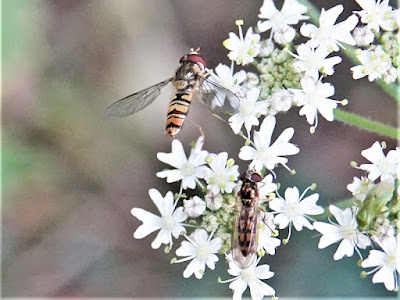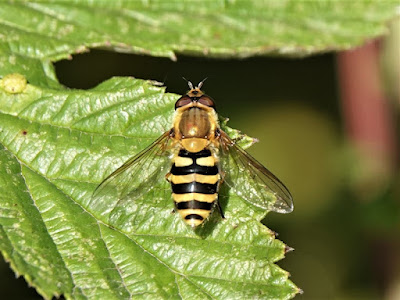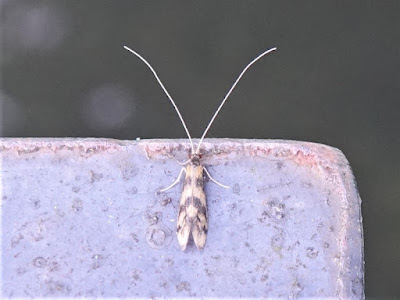17.0°C > 22.0°C: Early cloud dispersed for a while before more approached from the West. Light southerly breeze. Very good visibility.
Sunrise: 05:09 BST
* = a species photographed today
$ = my first sighting of the species for this year
$$ = my first ever recorded sighting of the species in the area
Priorslee Balancing Lake: 04:55 – 06:15 // 07:30 – 09:40
(175th visit of the year)
Bird notes:
- 19 Canada Geese when I arrived: eventually 34.
- up to four Greylag Geese.
- two broods of four and seven Mallard ducklings. All other Mallard together as "(near) adults".
- the duck Pochard reappeared briefly: where is she hiding out?
- two Tufted Duck flew West at 05:30.
- a number of the Moorhens seen are full-grown juveniles. These tend to stay hidden until they are fully independent.
- at least two broods of Coots were previously unseen. Adults and juveniles all lumped in the count.
- all seven juvenile Great Crested Grebes from the four broods were found again. The true number of adults present remains elusive as parents continually dive for food.
- another sighting of a juvenile Black-headed Gull.
- a more usual passing of Jackdaws and Rooks.
- I am not sue why there are so few Reed Warblers around. Most years they would be having another brood and would leave mid- to late-August. Apart from the lack of song and calls I am not seeing any dashing across between the reeds on the lake side as I usually do.
Bird(s) noted flying over here:
- 3 (?♂) Mallard flew East
- 2 (?♂) Tufted Duck: flew West
- 73 Wood Pigeons
- 5 Lesser Black-baked Gulls
- 72 Jackdaws
- 34 Rooks
Counts from the lake area:
- 34 Canada Geese: see notes
- 2 Greylag Geese
- 2 Mute Swans
- *33 (?♂) + 11 (2 broods) Mallard: see notes
- *1 (0♂) Pochard
- 10 Moorhens again
- 106 Coots
- >7 + 7 (4 broods) Great Crested Grebes: see notes
- 20 Black-headed Gulls: one of these a juvenile
- 7 Lesser Black-baked Gulls
- no Grey Heron
Hirundines etc. noted:
- 4 Swifts
- 3 Barn Swallows
- House Martins heard high over: not located
Warblers recorded (the figure in brackets is birds noted singing):
- 2 (0) Cetti's Warbler
- 10 (2) Chiffchaffs
- 2 (0) Reed Warbler
- 3 (2) Blackcaps
- 1 (0) Common Whitethroat
Noted on the West end street lamp poles around-dawn:
Moths:
1 Bird-cherry Ermine Yponomeuta evonymella
*1 Ruby Tiger Phragmatobia fuliginosa
1 Bird-cherry Ermine Yponomeuta evonymella
*1 Ruby Tiger Phragmatobia fuliginosa
Beetle:
*1 $$ ground beetle, possibly Paradromius linearis
*1 $$ ground beetle, possibly Paradromius linearis
Spiders, harvestmen etc.:
1 Bridge Orb-web Spider Larinioides sclopetarius
two other unidentified spiders
Noted later:
1 Bridge Orb-web Spider Larinioides sclopetarius
two other unidentified spiders
Noted later:
Butterflies:
Large White Pieris brassicae
` Green-veined White Pieris napi
Speckled Wood Pararge aegeria
Meadow Brown Maniola jurtina
Gatekeeper Pyronia tithonus
*Comma Polygonia c-album
Large White Pieris brassicae
` Green-veined White Pieris napi
Speckled Wood Pararge aegeria
Meadow Brown Maniola jurtina
Gatekeeper Pyronia tithonus
*Comma Polygonia c-album
Moths
many unidentified grass moths flying in to the middle distance
*3 Pale Straw Pearls Udea lutealis
1 Mother of Pearl Patania ruralis [was Pleuroptya ruralis]
1 caterpillar of Cinnabar Tyria jacobaeae
many unidentified grass moths flying in to the middle distance
*3 Pale Straw Pearls Udea lutealis
1 Mother of Pearl Patania ruralis [was Pleuroptya ruralis]
1 caterpillar of Cinnabar Tyria jacobaeae
Bees, wasps etc.:
Common Carder Bee Bombus pascuorum
Buff-tailed Bumblebee Bombus terrestris
Common Wasp Paravespula vulgaris
Common Carder Bee Bombus pascuorum
Buff-tailed Bumblebee Bombus terrestris
Common Wasp Paravespula vulgaris
Hoverflies:
*Bumblebee Blacklet Cheilosia illustrata
*Marmalade Hoverfly Episyrphus balteatus
Tapered Dronefly Eristalis pertinax
Meadow Field Syrph Eupeodes latifasciatus [Broad-banded Aphideater]
*Chequered Hoverfly Melanostoma scalare [Long-winged Duskyface]
Common Twist-tail Sphaerophoria scripta [Long Hoverfly; Common Globetail]
*Humming Syrphus Syrphus ribesii [Common Flower Fly]
Syrphus sp. S. ribesii / S. vitripennis
*$ Wasp Plumehorn Volucella inanis [was Lesser Hornet Hoverfly]
*Bumblebee Blacklet Cheilosia illustrata
*Marmalade Hoverfly Episyrphus balteatus
Tapered Dronefly Eristalis pertinax
Meadow Field Syrph Eupeodes latifasciatus [Broad-banded Aphideater]
*Chequered Hoverfly Melanostoma scalare [Long-winged Duskyface]
Common Twist-tail Sphaerophoria scripta [Long Hoverfly; Common Globetail]
*Humming Syrphus Syrphus ribesii [Common Flower Fly]
Syrphus sp. S. ribesii / S. vitripennis
*$ Wasp Plumehorn Volucella inanis [was Lesser Hornet Hoverfly]
Dragon-/Damsel-flies:
*Common Blue Damselfly Enallagma cyathigerum [Common Bluet]
Blue-tailed Damselfly Ischnura elegans [Common Bluetail]
*Common Blue Damselfly Enallagma cyathigerum [Common Bluet]
Blue-tailed Damselfly Ischnura elegans [Common Bluetail]
Caddis etc. flies:
none
none
Other flies:
*$$ blow-fly, possibly Melinda gentilis
otherwise only unidentified fly species
*$$ blow-fly, possibly Melinda gentilis
otherwise only unidentified fly species
Bugs:
none
none
Beetles:
7 Spot Ladybird Coccinella 7-punctata
Common Red Soldier Beetle Rhagonycha fulva
7 Spot Ladybird Coccinella 7-punctata
Common Red Soldier Beetle Rhagonycha fulva
Amphibians:
none
none
Spiders, harvestmen etc.:
none
none
New flowers for the year:
None
A duck Mallard (closest to the camera) with her brood of four well-grown ducklings. It is probably too soon to make judgment about the sex of the ducklings. However the bird on the left looks to have the plainest bill that might suggest it will be a drake.
A distant shot of the duck Pochard. The only occasion I saw here today.
How could I resist this Comma butterfly Polygonia c-album posing on the Teece Drive fence.
At the time I could only see the darker spot in the wings of this moth and thought it would be a Straw Dot Rivula sericealis. However editing the photo revealed more of the markings and it is in fact a worn Pale Straw Pearl moth Udea lutealis.
My second Ruby Tiger moth Phragmatobia fuliginosa here this year, this one on the overhanging lamp mechanism of a street lamp at the West end around dawn.
A Bumblebee Blacklet hoverfly Cheilosia illustrata. It is somewhat unusual for a hoverfly in often not being very approachable for a photo.
Compare and contrast: at the top a Marmalade Hoverfly Episyrphus balteatus. Below a female Chequered Hoverfly Melanostoma scalare. I have just noticed an unidentified bug lurking at the extreme right!
Good fortune here. This is a female Syrphus hoverfly (the eyes do not meet) and the left hind tibia is visible meaning this must be a Humming Syrphus S. ribesii or, as Obsidentify calls it, Common Flower Fly.
Not the best of angles as this Wasp Plumehorn Volucella inanis feeds on Meadowsweet Filipendula ulmaria. My first record of this species this year. It differs from the Hornet Hoverfly V. zonaria in having no orange on the abdomen.
My second Ruby Tiger moth Phragmatobia fuliginosa here this year, this one on the overhanging lamp mechanism of a street lamp at the West end around dawn.
I still don't seem able to find any Azure Damselflies Coenagrion puella at the moment. All those I photograph turn out to be Common Blue Damselflies Enallagma cyathigerum, like this male.
Also on a street lamp pole around dawn was this ground beetle, possibly Paradromius linearis.
(Ed Wilson)
------------------------------------------------------------------------------------------------------
In the Priorslee Avenue tunnel:
Moths: [28 species here before today; no additions]
none
none
Flies:
1 cranefly Tipula lateralis
2 moth flies Psychodidae sp. [Drain Fly or Owl Fly]
14 midges of various species.
1 cranefly Tipula lateralis
2 moth flies Psychodidae sp. [Drain Fly or Owl Fly]
14 midges of various species.
Arthropods:
2 White-legged Snake Millipedes Tachypodoiulus niger
2 White-legged Snake Millipedes Tachypodoiulus niger
Spiders, harvestmen etc.:
1 Missing Sector Orb-web Spider Zygiella x-notata [Silver-sided Sector Spider]
2 female harvestmen Leiobunum rotundum
1 other unidentified harvestman
(Ed Wilson)
The Flash: 06:20 – 07:25
1 Missing Sector Orb-web Spider Zygiella x-notata [Silver-sided Sector Spider]
2 female harvestmen Leiobunum rotundum
1 other unidentified harvestman
(Ed Wilson)
------------------------------------------------------------------------------------------------------
The Flash: 06:20 – 07:25
(171st visit of the year)
Bird notes:
- just 17 Tufted Duck today many now almost impossible to sex.
- three Great Crested Grebes as yesterday.
Bird(s) noted flying over here:
- 5 Jackdaws
Noted on / around the water:
- 72 Canada Geese
- 30 Greylag Geese
- 6 Mute Swans
- 14 Mallard
- 17 (?♂) Tufted Duck
- + 1 (1 broods) Moorhens
- 91 + 10 (4 dependent broods) Coots
- 3 Great Crested Grebes
- 1 Black-headed Gull: adult
- 1 Grey Heron
Hirundines etc. noted:
- House Martin(s) heard only high over
Warblers recorded (the figure in brackets is birds noted singing):
- 5 (1) Chiffchaffs
- 4 (3) Blackcaps
Noted around the area:
Bird notes:
- just 17 Tufted Duck today many now almost impossible to sex.
- three Great Crested Grebes as yesterday.
Bird(s) noted flying over here:
- 5 Jackdaws
Noted on / around the water:
- 72 Canada Geese
- 30 Greylag Geese
- 6 Mute Swans
- 14 Mallard
- 17 (?♂) Tufted Duck
- + 1 (1 broods) Moorhens
- 91 + 10 (4 dependent broods) Coots
- 3 Great Crested Grebes
- 1 Black-headed Gull: adult
- 1 Grey Heron
Hirundines etc. noted:
- House Martin(s) heard only high over
Warblers recorded (the figure in brackets is birds noted singing):
- 5 (1) Chiffchaffs
- 4 (3) Blackcaps
Noted around the area:
Butterflies:
Large White Pieris brassicae
Large White Pieris brassicae
Moths [on street lamp poles and in the grass] [58 species here before today: one addition]
*2 $ Italian Bark Moths Metalampra italica [was Italian Tubic]
1 Garden Grass-moth Chrysoteuchia culmella [was Garden Grass-veneer]
1 Small Fan-footed Wave Idaea biselata: a dead individual
*4 Single-dotted Waves Idaea dimidiata
*1 Swallow Prominent Pheosia tremula: a second brood.
*2 $ Italian Bark Moths Metalampra italica [was Italian Tubic]
1 Garden Grass-moth Chrysoteuchia culmella [was Garden Grass-veneer]
1 Small Fan-footed Wave Idaea biselata: a dead individual
*4 Single-dotted Waves Idaea dimidiata
*1 Swallow Prominent Pheosia tremula: a second brood.
Bees, wasps etc.:
Buff-tailed Bumblebee Bombus terrestris
Common Wasp Paravespula vulgaris
Buff-tailed Bumblebee Bombus terrestris
Common Wasp Paravespula vulgaris
Hoverflies:
Marmalade Hoverfly Episyrphus balteatus
Tapered Dronefly Eristalis pertinax
Common Spotted Field Syrph Eupeodes luniger [Lunuled Aphideater]
Chequered Hoverfly Melanostoma scalare [Long-winged Duskyface]
Marmalade Hoverfly Episyrphus balteatus
Tapered Dronefly Eristalis pertinax
Common Spotted Field Syrph Eupeodes luniger [Lunuled Aphideater]
Chequered Hoverfly Melanostoma scalare [Long-winged Duskyface]
Dragon-/Damsel-flies:
none
none
Caddis etc. flies:
*Grouse Wing caddis fly Mystacides longicornis
*Grouse Wing caddis fly Mystacides longicornis
Other flies:
various different midges and flies
various different midges and flies
Bugs:
*$$ mirid bug Campyloneura virgula
*$$ mirid bug Campyloneura virgula
Beetles:
7 Spot Ladybird Coccinella 7-punctata
Common Red Soldier Beetle Rhagonycha fulva
7 Spot Ladybird Coccinella 7-punctata
Common Red Soldier Beetle Rhagonycha fulva
Spiders, harvestmen etc.:
1 harvestman Dicranopalpus ramosus/caudatus only
1 harvestman Leiobunum blackwalli / rotundum
1 harvestman Dicranopalpus ramosus/caudatus only
1 harvestman Leiobunum blackwalli / rotundum
New flowers for the year:
None
There were two of these tiny moth flying around and around alongside the Wesley Brook as it flows (or not at the moment!) between the academy and houses. Eventually one landed briefly and the photo revealed it to be an Italian Bark Moth Metalampra italica. I had one in almost exactly the same place three years ago that the Shropshire Recorder identified for me. The species is not well illustrated as it is a rapidly-spreading recent-colonist.
One of four Single-dotted Wave moths Idaea dimidiata that I found. One was on a street lamp pole and three were, like this, on the vegetation below different street lamps. I rarely seem to see moths below the street lamps along the West side of the Balancing Lake for some reason.
Another challenging moth but only because it was in full sun at the top of a street lamp pole. There are two species that are not easy to separate, the distinction being the marking at the very wing tip. Here there are only white streaks which identifies it as a Swallow Prominent Pheosia tremula. Had there been a small white wedge it would have been a Lesser Swallow Prominent P. gnoma. I have seen both species on the street lamp poles in the wooded area at the top end. At this date this is a second generation individual.
The moustache-like yellow marks (lunules) identify this hoverfly as a Common Spotted Field Syrph Eupeodes luniger.
On the handrail of one of the footbridges I found this Grouse Wing caddis fly Mystacides longicornis . I have to say this individual is distinctly "shorticornis" compared to most but that does not seem to make it a different species - no other caddis fly shares the wing markings.
This mirid bug is a new species for me. The relatively long antennae and the bright yellow cuneus help to identify it as Campyloneura virgula . No vernacular name. Also on the handrail of one of the footbridges.
(Ed Wilson)
There were two of these tiny moth flying around and around alongside the Wesley Brook as it flows (or not at the moment!) between the academy and houses. Eventually one landed briefly and the photo revealed it to be an Italian Bark Moth Metalampra italica. I had one in almost exactly the same place three years ago that the Shropshire Recorder identified for me. The species is not well illustrated as it is a rapidly-spreading recent-colonist.
(Ed Wilson)


















